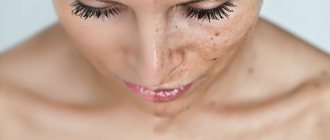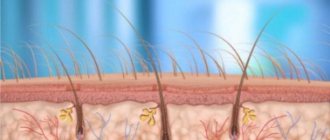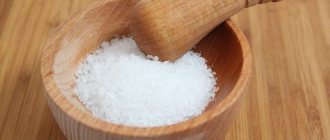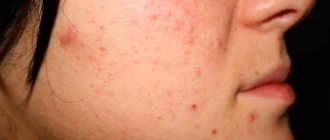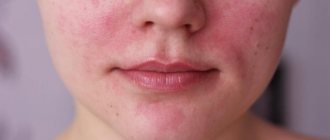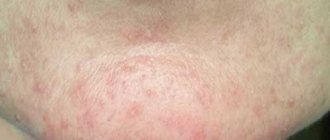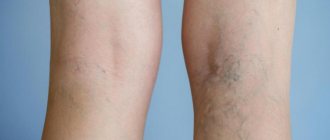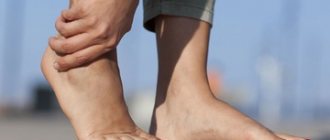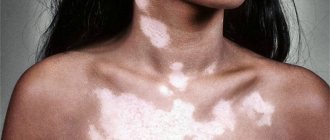It sounds boastful, but readers sometimes say that I should start writing books. In response, I purr narcissistically and add that I would generally only write about lofty things: spirituality, happiness, and all that. Broadcast and express, striking with the depth of thought. And when it already seems that my dharma is to write about God, enlightenment and not a millimeter below, harsh reality brings me back down to earth and reminds me: stories about acne are our everything. Therefore, the topic of a new series of articles will be the treatment of demodicosis on the human face.
Causes of demodex - eliminating the risk factor
It is considered an absolute norm if a Demodex mite is found on a person’s body, but its number should not exceed 3-4 pieces. per 1 sq. see sebaceous gland, if this number has increased to 5-6 pcs. per 1 sq. see, then you need to immediately contact a specialist. The very fact that “uninvited guests” live on our body (as if “invited” guests would cause less negative emotions) causes an unpleasant feeling of infection. But you will immediately know that there are a lot of ticks.
A healthy organism develops a stable relationship with the parasite (carriage), and with this “cohabitation” the influence of the tick is restrained by the immunity of the host-carrier. However, this delicate balance can easily lead to illness.
Factors that can disrupt the balance and cause demodicosis disease:
- solar radiation;
- surgical interventions on the eyes;
- stress;
- abuse of baths or saunas;
- a sharp decline in the immune system;
- gastrointestinal diseases;
- liver diseases;
- malignant tumors;
- various skin diseases (seborrheic dermatitis, rosacea, acne, perioral dermatitis);
- hormonal imbalance (pregnancy, diabetes, Itsenko-Cushing's disease);
- sudden change in temperature;
- bad habits;
- use of low-quality cosmetics;
- toxic external environment.
Why did you decide to talk about the treatment of demodicosis on the face?
After I mentioned my ugly secret in a review of the most effective gel for scars from Thailand, I immediately started receiving clarifying questions in PM. Remembering my own long and sad medical history, I am unable to refuse requests to share the experience of defeating demodex with those who have suffered this stupid fate.
By the way, here is a gel for scars, which will be very useful for any demodicosis specialist to get rid of terrible post-acne after demodex.
I sincerely hope that the information will be truly useful, and that my recovery, consolidated over the years, will inspire those currently suffering. Be strong, friends! Truly I tell you: demodicosis can be completely cured if you are willing to work seriously. Don’t just rub in antibiotics and drink vitamins, but slightly change your lifestyle. Perhaps even thinking.
The good news is that treatment is not expensive at all. If you wish, of course, you can spend many great thousands of rubles. Or even which currency is more powerful. But this is for cases when there is no sufficient knowledge about your enemy - the tick. Or when the income is so high that, in order to save nerves and effort, you can prescribe the best dermatologist from Germany, but such people hardly have time to read author’s blogs.
I’m not a doctor, but I checked something that not every dermatologist will tell you! - I can tell you. Because dozens of medications have been tried - external, internal, intravenous and intramuscular.
In addition, it is highly desirable to use very high quality and extremely natural cosmetics. Asian remedies, which I never tire of talking about, effectively help me maintain healthy skin in that vigorous state that a parasite cannot.
You will find lots of useful tips on skin care for demodicosis here.
Another important factor in preventing relapses is natural medicines: herbs, Ayurvedic or oriental medicine, spices, etc. There are stories about all this ahead. If the medical history is not interesting to read, you can immediately go to the end of the article, where a plan of detailed materials on a given topic is listed.
How and why did my demodicosis begin?
The case began eight years ago.
My skin has always been slightly problematic - sometimes a pimple will pop out, sometimes blackheads will start to irritate me. The eternal glow of a ruddy pancake an hour after powdering, etc. things. Looking objectively now, from the height of experience and slightly more swollen gray matter, these were mere trifles. Overall, the face was soft, smooth, and had a healthy complexion. My experiences as a young lady were due to a lack of literacy in matters not so much of caring for oily skin, but rather to the typical ignorance of the average person in maintaining their own health.
Plus self-doubt - alas, I was not taught from childhood to love and accept myself as I am. In connection with this, the problem of tiny acne has always been inflated by a restless mind to unimaginable proportions.
The spring of 2008 came, full of a whole bunch of important events for me. I was still living in my small homeland, in a tiny Siberian town. The following happened.
Signs and symptoms of demodex - how not to confuse it with eczema
Demodicosis has different symptoms on different areas of the skin. Common symptoms include peeling, redness of the skin, itching, burning, tingling and dilated blood vessels on the surface of the face.
The following types of demodicosis can be distinguished:
- cutaneous;
- ophthalmic
The cutaneous type of demodicosis is characterized by inflammatory processes in the area above the eyebrows, on the cheeks and chin. Much less often, demodicosis appears on the chest, back or ears. Acne begins to develop, caused by inflammation in the sebaceous glands and hair follicles.
Also with this type of demodicosis you can observe:
- itching (worst in the evening and at night);
- increased oily shine on the skin of the face;
- redness of the skin (arterial hyperemia);
- a swollen nose or its wings (an indicator of advanced disease).
Regarding the ocular type of demodicosis, it is worth noting the following symptoms:
- eye strain or fatigue, a feeling of sand in the eyes (appears due to inflammation of the hair follicles on the ciliary layer);
- excessive sticking of eyelashes and their loss;
- painful appearance of the upper eyelid (redness and inflammation).
If these signs of the disease are present, patients also often experience psoriasis, acne, perioral dermatitis, and styes.
Symptoms
A rosacea-type rash appears on the face - these are large red coals. If there are a lot of mites, then convex granulomas are formed. They do not itch and do not bother a person. But the number of acne continues to increase, the skin becomes lumpy and greasy. Vascular networks and capillaries expand.
The longer mites live and reproduce, the more greasy the skin becomes. Against the backdrop of a long life of demodex without treatment of the pathology, an allergic component is added over time, which increases swelling and redness. A vicious circle is formed.
In men with demodicosis, the problem of rhinophyma . This is an inflammatory lesion of the skin of the nose with hypertrophy of all elements. Before the appearance of rhinophyma, demodicosis developed in the skin for several years.
Demodicosis of the head is a rare pathology that often develops against the background of seborrhea and is characterized by hair loss, flaking and the appearance of dandruff, itching of the scalp.
Interestingly, the demodex mite can live quietly in small numbers in the human epidermis, that is, on the top layer of skin. It does no harm and feeds on dead cells.
Ticks can be picked up from dogs. German shepherds and French bulldogs are often affected by it. But toy terriers and cocker spaniels do not suffer from this pathology. Demodicosis is also transmitted from an infected person through close household contact and the use of pillows and shared towels.
If demodex is localized on the edge of the eyelids, then the symptoms are as follows:
- sensation of a foreign object in the eye,
- redness and irritation of the eyelids,
- sticking and loss of eyelashes followed by abnormal growth,
- eye fatigue.
Read more about demodectic blepharitis here.
If the human body begins to produce more sebum, then there is a risk of demodicosis becoming more active. An exacerbation of the pathology is observed in the autumn-winter period, when the nonspecific resistance of the skin decreases. Hormonal changes in the body, especially local hormonal ointments, can provoke demodicosis.
Effective folk remedies - how to treat demodex
At the initial stages of the development of the disease, traditional methods of treatment can be used. But it is worth remembering that with an advanced form, more drastic therapy will be needed. Patients who have coped with demodex definitely recommend using both methods simultaneously: pharmaceutical ointments and folk remedies: herbal decoctions, lotions, masks. And to prevent the parasites from returning, do not forget to systematically iron your things with a hot iron. Bed linen, T-shirts, panties, nightgowns must be ironed.
How to treat demodex - wormwood tincture
Wormwood solution. Take 4-5 tablespoons of finely ground wormwood and pour 1 liter of boiling water. Boil the solution for 5-7 minutes, then leave to infuse for 3 hours. The drink should be taken orally after meals for a week.
The first day we take half a glass every hour (even at night), then, starting from the second day, half a glass every 2 hours. It is important to remember that the broth should always be fresh. For those who like it sweeter, you can add a spoonful of honey.
How to treat demodex eyelids
Oak bark. Oak bark is good for making lotions for sore eyelids. To do this, you need to grind a teaspoon of bark, pour a glass of boiling water and let it brew for 5 minutes. You can apply cotton pads soaked in the broth to your eyes, 2-3 times a day for 10 minutes. The course of treatment is up to 14 days.
Castor oil. The oil can be used to treat reddened areas of the skin, eyelids, eyelashes or eyebrows, but in no case should you drop it into your eyes, as this can cause a burn to the mucous membranes. Do this procedure in the morning and evening.
How to treat demodex on the face and back
Celandine. This method only helps with skin lesions. Take 250-300 mg of fresh celandine roots, fill them with 300-350 ml of refined sunflower oil. Place on a sunny windowsill for a few days. After the specified time, pour the strained mixture into a dark glass container. Place in the refrigerator. Apply to reddened skin every day before going to bed.
Aloe juice. To make lotions with aloe juice, you need to squeeze the required number of drops of juice from the plant onto a sterile bandage. Apply 2-3 times a day.
Masks against demodex on the forehead
Onion mask. Onions are an excellent natural antiseptic. Finely chop the onion, add a couple of drops of tea tree oil, apply to hair, paying special attention to the roots. Wrap with cling film and leave for 35-40 minutes. Rinse off with warm water.
Tea tree oil. An excellent oil that dries out minor inflammations and soothes irritations. Apply precisely.
There is no need to wait for instant results if you have a running form. At the initial stage, the course of treatment is 14 days, then a week's break and a repeat course. With advanced forms, demodex can be cured in a month.
General manifestations of the disease, diagnosis
Demodex, or subcutaneous mite, parasitizes humans, and it is impossible to notice it under normal conditions. For life, it chooses the sebaceous glands of the face, body and hair follicles.
The subcutaneous parasite sucks nutrients from the hair roots, which leads to inflammation and hair loss. The disease also manifests itself in the form of inflammation on the face, ears and eyelids. The reasons for the development of this disease may be the following:
- disruption of the immune system;
- new cosmetics;
- excessive use of cosmetic procedures such as solariums, baths, saunas;
- constant stress;
- disorders in the gastrointestinal tract.
The lower the body's protective functions, the easier it is to become infected.
Symptoms of infection
- Small scales appear at the roots of the eyelashes.
- The eyelids swell.
- Due to the appearance of plaque on the eyelashes, they constantly stick together.
- Lumpiness appears all over the skin of the face.
- Hair falls out. This can lead to complete baldness.
- Acne, pimples and ulcers appear all over the body and entire face.
- The nose noticeably increases in volume and its color changes.
- Itching appears on the affected areas of the body, which intensifies in the evening.
- The skin takes on a greasy appearance around the nose and cheeks.
Diagnosis is carried out by studying the effects and manifestations of the tick. Here it is very important not only to detect the infection, but also to determine the number of individuals. Skin scrapings are often used. But for a more thorough diagnosis, an extractor is used to extract the contents of the follicle.
There is another method for diagnosing this infection. Cyanoacrylate is applied to the rash. The treated area is covered with a coverslip. After the glue dries, it comes off the surface of the skin. This is how both a sample of the stratum corneum and the contents of the follicle are obtained.
Is it possible to get rid of the disease forever?
Answer from dermatologists: you can! But to do this, you need to seek qualified help from a specialist who will identify the type of tick (long (Demodex folliculorum) and short (Demodex brevis), each with its own regimen and duration of therapy) and prescribe the correct treatment.
It is important to adhere to the doctor’s recommendations, as well as improve immunity and metabolism in your body. Taking vitamins in their natural form (fresh vegetables, fruits, berries) and reducing stressful situations are good for this. If all these conditions are met, the disease may disappear until the end of life. It is important to remember that everyone’s disease progresses strictly individually, so even the best remedies do not guarantee that a relapse will not occur.
When to treat?
Skin treatment in the initial stages is faster and easier, and has a positive prognosis. Early diagnosis of demodicosis allows you to timely identify the internal disorders that caused the disease and prevent their development and complications. If time is lost, significant damage is caused to the skin, curing demodex and restoring the epidermis will be difficult and expensive. Treatment during an exacerbation and when complicated by infections has its own characteristics; the doctor may prescribe additional antibacterial drugs or potent drugs.
Treatment of demodex with chlorophyll
The results of the treatment are visible after just a week of use. It is necessary to drip three drops of liquid chlorophyll into the eyes, plus Amitrosine as an ointment for the eyelids and around them. Do all this twice a day. You can either buy liquid chlorophyll, although it is not cheap, or make it yourself. Any leafy green herb will work to make it. The juice that you squeeze out of it will contain chlorophyll. Only such fresh chlorophyll will work for no more than 15 minutes, so there is no point in storing it for future use.
You should stop washing with regular soap and use laundry soap. Go on a kind of diet, increasing the amount of foods enriched with potassium and vitamin A. Drink water, mixing it directly with honey in the amount of one tablespoon, iodine (one drop is enough) and apple cider vinegar (also a teaspoon).
Additional recommendations
To strengthen and consolidate treatment at home, it is necessary to properly care for your skin and follow a diet. Proper care involves regularly cleansing the skin and using products to reduce sebum production.
Rules of care:
- Wash your face no more than 1-2 times a day.
- Use wet wipes instead of towels.
- You cannot use soap to wash your face. Gel Cleanans, Klerasil, Sebium cleanses the skin well and carefully.
- Use disinfectant alcohol solutions - calendula tincture, chloramphenicol, camphor.
- To combat dryness, use moisturizers - Panthenol, Avene for sensitive skin.
- Do not use cosmetics, avoid prolonged exposure to the sun.
- You cannot visit the bathhouse, sauna, solarium, apply nourishing masks, or do warming procedures.
- Replace feather pillows with products with synthetic filling. Wash scarves and hats every 2 days.
Diet therapy is an integral part of the treatment of demodicosis. During therapy, it is necessary to exclude spicy, salty foods and sweets from the diet. You cannot drink alcoholic beverages.
Can demodicosis be completely cured?
Complete recovery is possible only with complex therapy under the supervision of a specialist.
Successful treatment of demodicosis is possible only with complex therapy. It is important to understand that eliminating internal causes, although it is a prerequisite, will not in itself cure demodicosis that has already developed. Mite colonies will continue to multiply and infect healthy areas of the skin. Completing a course prescribed by a dermatologist is mandatory to get rid of the disease. According to statistics, among those who are cured of a tick, 10% become ill again, so even after completing treatment it is important to follow the recommendations of a specialist.
Recommendations for getting rid of ticks
It is important to understand that self-indulgence can lead not only to prolongation of the disease, but also to an exacerbation. That is why, in order to achieve a positive result, the dermatologist prescribes an individual treatment regimen in each case. However, it is important to consider the necessary rules during treatment. They will help you get rid of the disease faster. If you do not follow them, the treatment will not work.
- After washing, dry with disposable paper towels.
- All hygiene products and shampoos must be organic.
- Decorative cosmetics are strictly prohibited (all types of creams, tonics, scrubs).
- Do not visit bathhouses or solariums.
- Shower very quickly, do not take baths.
- The skin should not be exposed to direct sunlight.
- Strictly deny yourself foods prohibited for this disease and normalize the activity of the liver and gastrointestinal tract.
- All patient's clothes and towels should be washed and ironed regularly.
- It is important to identify the reasons that could provoke demodicosis.
After recovery, you must constantly follow all the doctor’s recommendations to prevent a relapse.
The right diet for recovery
When treating any disease, nutrition is the most important component of success. The essence of the diet for demodicosis is to eat foods that will stop the excessive reproduction of individuals and help strengthen the immune system.
Give preference to the following foods:
- vegetables and unsweetened fruits, berries;
- dairy and fermented milk products;
- low-fat varieties of fish or meat;
- cereals and grain crops.
It is strictly forbidden to eat honey, citrus fruits, smoked meats, too salty, spicy or sweet foods, chocolate, sauces and seasonings.
Be sure to increase the amount of water you drink daily, as it will help quickly remove tick waste from the body.
Eat often, but little by little, chewing your food thoroughly. Do not eat too hot foods or drink hot drinks - they contribute to the expansion of pores, and this negatively affects the treatment.
Keeping a healthy diet, give up alcohol and smoking. Remember - it is important to follow a diet until complete recovery! You shouldn't give up halfway through, even if you notice significant improvements.
